Manta 42 MK II
Easy handling and clever design make this American-built cat the choice of liveaboard cruisers
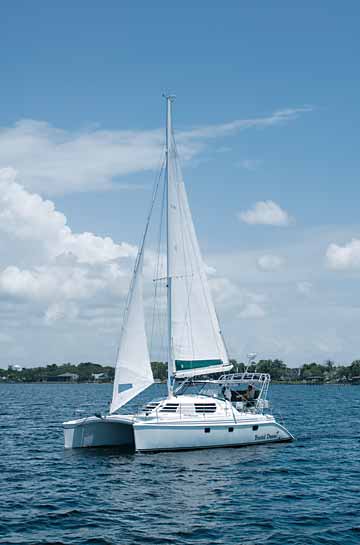 It was hot and still, I was growing impatient. "Relax, go have lunch," Pat Reischman said. "The afternoon sea breeze will kick in around 1400." He was right, no sooner had we returned than a soft breeze sprang up, rippling the previously placid waters of the Manatee River in Bradenton, Florida. Reischman, who has been with Manta Catamarans since its inception 10 years ago, fired up the 30-horsepower Volvos and used the inherit maneuverability of twin screws to ease the handsome cat out of its slip. Out in the river we hoisted the main, well actually, we watched the main go up courtesy of an electric self-tailing winch mounted next to the helm. Then we raised the self-tacking Camber Spar jib and snuffed out the diesels. With the apparent wind hovering at all of 10 knots, we tacked down the river. We touched 6 knots a few times but you wouldn't have known it if you were not looking at the GPS, the ride was silky smooth.
It was hot and still, I was growing impatient. "Relax, go have lunch," Pat Reischman said. "The afternoon sea breeze will kick in around 1400." He was right, no sooner had we returned than a soft breeze sprang up, rippling the previously placid waters of the Manatee River in Bradenton, Florida. Reischman, who has been with Manta Catamarans since its inception 10 years ago, fired up the 30-horsepower Volvos and used the inherit maneuverability of twin screws to ease the handsome cat out of its slip. Out in the river we hoisted the main, well actually, we watched the main go up courtesy of an electric self-tailing winch mounted next to the helm. Then we raised the self-tacking Camber Spar jib and snuffed out the diesels. With the apparent wind hovering at all of 10 knots, we tacked down the river. We touched 6 knots a few times but you wouldn't have known it if you were not looking at the GPS, the ride was silky smooth.
We were sailing hull No. 98, the 42 MK II, the latest evolution in the Manta story. We had just come from the factory in Sarasota where we inspected the final touches being applied to hull No. 100, which was scheduled for a ceremonial launching a few days later. Manta, one of the few cruising cats built in the United States, is a welcome success story.
"All I wanted was to buy a boat," says Manta President Dan Even. "But I bought a boat and the company."
Even, a successful entrepreneur from Southern California, was just what the struggling firm needed. He streamlined the manufacturing process and brought professionalism to the marketing department. He and Reischman make a good team and Manta has carved out a solid niche in the industry.
"People cruise and live aboard our boats," Reischman said. "We don't build charter boats. We may have the highest percentage of liveaboards in the industry. Our owners are our best salesmen."
And the boat also speaks for itself, several have completed long cruises including at least two circumnavigations.
The details
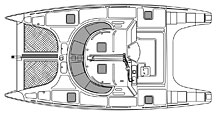 The original Manta 38 was designed in 1993 and went into production in 1996 in St. Petersburg. The first major change to the molds increased the hulls to 40 feet and then later to 42 feet. The MK II was introduced with hull No. 82 in 2002 when the company moved to its current facility in Sarasota. The level of fit and finish was upgraded, headroom was increased and all the tweaks and twists that Reischman had developed over the years were incorporated into a complete world cruising cat.
The original Manta 38 was designed in 1993 and went into production in 1996 in St. Petersburg. The first major change to the molds increased the hulls to 40 feet and then later to 42 feet. The MK II was introduced with hull No. 82 in 2002 when the company moved to its current facility in Sarasota. The level of fit and finish was upgraded, headroom was increased and all the tweaks and twists that Reischman had developed over the years were incorporated into a complete world cruising cat. 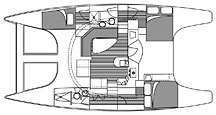
The stout fiberglass hulls and bridgedeck are layed up with vinylester resins for the most part, cored with Corecell and vacuum bagged. The hull-and-deck joint is laminated, making it more or less leakproof. Bulkheads and subfloors are made with high-tech Nida-Core, which is strong and extremely light, and then covered with veneers. Catamaran builders are constantly searching for materials to reduce weight, and even in cruising cats, weight is the enemy. 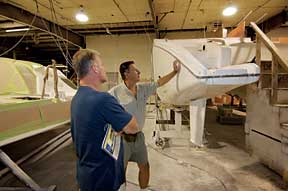
The Manta 42 MK II uses stub keels, not daggerboards, and the fin sections are integral to the hull and give the boat a draft of just 3 feet, 8 inches. Twin rudders are made with high-density foam with a fiberglass covering. The rudderstocks are beefy 2-inch stainless steel. There are collision bulkheads with watertight compartments in the ends of each hull. Overall the quality of construction is impressive and Manta offers a five-year structural and blister warranty.
On deck
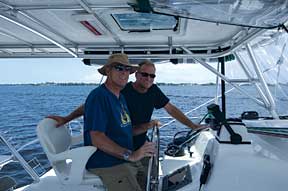 I took the helm as we worked our way down river. The adjustable helmsman seat puts you right where you need to be. You're not only behind the bulkhead-mounted wheel, with the engine controls easily accessible and sailing instruments readily viewed, but you are also in position to handle virtually every sail control line. Halyards, sheets, downhauls and the single-line reefing lines are led to stoppers and then on to the electric winch on the deckhouse, all within reach of the helm. Further, with the self-tacking Camber Spar jib, tacking simply requires that you turn the wheel as both sails look after themselves. The visibility from the helm is excellent, and this is not always the case on a cruising cat. I especially like the overhead hatch that provides a glimpse of the main, and when cracked open, a bit of air.
I took the helm as we worked our way down river. The adjustable helmsman seat puts you right where you need to be. You're not only behind the bulkhead-mounted wheel, with the engine controls easily accessible and sailing instruments readily viewed, but you are also in position to handle virtually every sail control line. Halyards, sheets, downhauls and the single-line reefing lines are led to stoppers and then on to the electric winch on the deckhouse, all within reach of the helm. Further, with the self-tacking Camber Spar jib, tacking simply requires that you turn the wheel as both sails look after themselves. The visibility from the helm is excellent, and this is not always the case on a cruising cat. I especially like the overhead hatch that provides a glimpse of the main, and when cracked open, a bit of air. 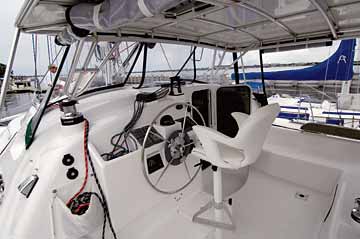 The cockpit is big and, more importantly, comfortable. The athwart seat aft has raised padded backrests. There is also a wonderful swing seat mounted from the arch support that gives you a helm-level view from the stern. Fiberglass storage boxes below the seat are perfect for stowing loose deck gear. The stern steps make all water sports enticing, and I like the arched railing leading down to the telescoping ladders.
The cockpit is big and, more importantly, comfortable. The athwart seat aft has raised padded backrests. There is also a wonderful swing seat mounted from the arch support that gives you a helm-level view from the stern. Fiberglass storage boxes below the seat are perfect for stowing loose deck gear. The stern steps make all water sports enticing, and I like the arched railing leading down to the telescoping ladders.
The entire cockpit is covered with a fiberglass top that incorporates an aluminum frame and radar arch. It is impressive, and strong enough to walk on to corral the mainsail. The mainsheet traveler has been eliminated, freeing up even more space in the cockpit. The boom is controlled by a 20:1 Garhauer vang in lieu of the traveler, an arrangement with a short lever arm that can really load up the boom. I like the fact that the entry door from the cockpit to the cabin is watertight and more like a hatch than a sliding patio door.
Most of the sailing hardware is by Harken and the deck gear is heavy duty and backed with aluminum plates molded into the deck. Stainless steel handrails are well placed on the deckhouse as you make your way forward and the molded nonskid offers good traction. Of course, cats don't heel so you are not prone to flopping about anyway. The 28-inch stanchions are well supported and when you get to the bow there are nice seats mounted on the rails.
Large lazarettes in the forward hull sections are good for fenders, or in the case of our test boat, big enough to house an eight-kilowatt generator. There are six Bowmar stainless steel deck hatches and nine stainless steel opening ports.
The fractional sailplan includes a full-batten 10.3-ounce main and the small self-tacking jib. The main has two reef points, each with a clever single line arrangement. Without sheets and leads to tweak, the Camber Spar, which is fitted inside the sail, helps maintain jib shape. It sure makes sailing easy and I confess, I was surprised how well it set and how easily we moved in light air. In heavy going, this hank-on jib makes a good storm sail, although I can envision the stainless spar causing a bit havoc when it does have to come down in severe weather. Deep reaching and running may require the furling spinnaker, called a screecher by some. This sail includes a Kevlar luff that it furls around and the Facnor furling tack gear can be shifted from the center of the boat to either side, adding to the spinnaker effectiveness.
Down below
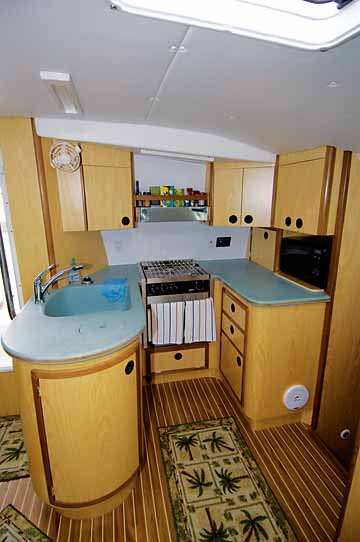 The Manta interior was not designed to stuff as many people as possible aboard for a one-week charter in paradise. It was designed for long-term cruising and living aboard. It's perfect for a couple with frequent guests or a family. The plan includes, in cat and powerboat lingo, a galley up. This means the galley is in the saloon, not down in one of the hulls.
The Manta interior was not designed to stuff as many people as possible aboard for a one-week charter in paradise. It was designed for long-term cruising and living aboard. It's perfect for a couple with frequent guests or a family. The plan includes, in cat and powerboat lingo, a galley up. This means the galley is in the saloon, not down in one of the hulls. 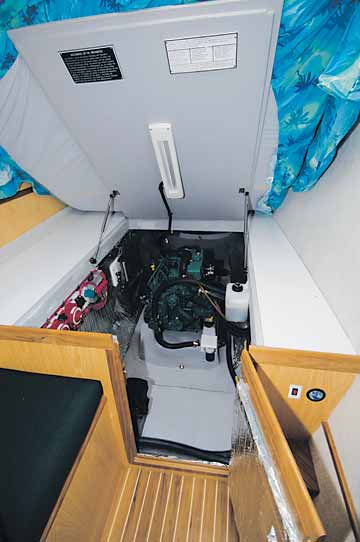
The U-shaped galley is immediately to port when you enter the cabin. It includes a decent amount of counter and storage space, nicely finished in Swanstone. There is a large single sink and a Force 10 three-burner stove and oven. The huge, well-insulated refrigeration/freezer is opposite, forward. Manta uses six inches of foam and the 12-volt refrigeration system on the test boat had everything iced down nicely.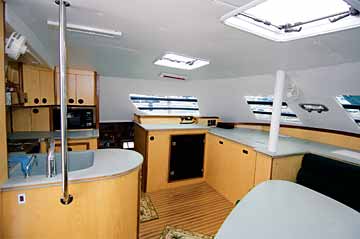 Continuing on the port side, there is a chart table with the electrical panel below. A quick inspection behind the custom panel revealed tidy, well-organized and labeled wiring. An L-shaped settee with an adjustable table with two floating stools is to starboard. From the settee you have a nice view of the flat screen television mounted on the aft bulkhead. Manta's trademark louvers mounted on the forward facing ports are very effective at reducing direct sunlight and heat without limiting visibility. From efficient and cool CCF overhead lights to built-in screens, to LED courtesy lights, Manta has applied many deft touches that are appreciated by people who spend a lot of time aboard.
Continuing on the port side, there is a chart table with the electrical panel below. A quick inspection behind the custom panel revealed tidy, well-organized and labeled wiring. An L-shaped settee with an adjustable table with two floating stools is to starboard. From the settee you have a nice view of the flat screen television mounted on the aft bulkhead. Manta's trademark louvers mounted on the forward facing ports are very effective at reducing direct sunlight and heat without limiting visibility. From efficient and cool CCF overhead lights to built-in screens, to LED courtesy lights, Manta has applied many deft touches that are appreciated by people who spend a lot of time aboard. 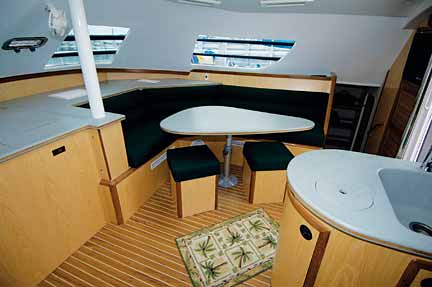 The port hull is the owner's sanctuary. The aft cabin features a fore-and-aft queen berth, a dressing seat and cedar-lined hanging lockers. Going forward, there's a bookcase in the companionway, which is a great idea. Forward is a private head and fully enclosed shower.
The port hull is the owner's sanctuary. The aft cabin features a fore-and-aft queen berth, a dressing seat and cedar-lined hanging lockers. Going forward, there's a bookcase in the companionway, which is a great idea. Forward is a private head and fully enclosed shower.
The starboard hull includes an athwartship queen aft and an intriguing array of options for the forward cabin. Some choose a workroom, others an office, and some make it a third cabin. Our test boat was fitted with a double berth and a washer/dryer unit, in essence making it a laundry room. Yes, this boat is intended for living aboard.
The Volvo diesels are located under the berths in each aft cabin. This can be noisy if you are trying to sleep when motoring, however, the tradeoff in access is worth any discomfort. The bunk boards are on pneumatic arms and when they are lifted, you have complete access to each engine.
The Volvos are fitted with saildrive lower units with three-bladed folding props. Reischman noted that they each burn about half a gallon at 2,800 rpms translating into 7-plus knots of boat speed. The aluminum fuel tank has a 120-gallon capacity. Manta has fitted a Puratec fuel purification system, which services both engines and the generator and will come in handy if you take on suspect diesel in a faraway port.
Under sail
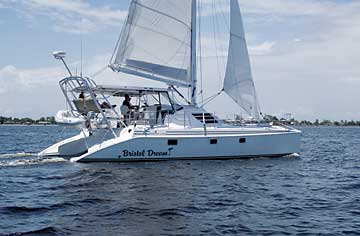 Back on the river, the wind picked up a bit as we eased off onto a close reach. The helm was well balanced and the Whitlock steering nice and tight. Falling off onto a broad reach, we maintained 5 knots. The best test of the 42 MK II's motion in a seaway came when an oblivious motoryacht steamed by at full throttle, sending a large wake cascading our way. How did it handle it? Well, none of our water bottles were upset.
Back on the river, the wind picked up a bit as we eased off onto a close reach. The helm was well balanced and the Whitlock steering nice and tight. Falling off onto a broad reach, we maintained 5 knots. The best test of the 42 MK II's motion in a seaway came when an oblivious motoryacht steamed by at full throttle, sending a large wake cascading our way. How did it handle it? Well, none of our water bottles were upset.
I made my way forward as we clipped along. You have a nice choice of places to hang out. You can sprawl on the trampoline or take a seat on the bow. From the bow seat I had a nice view of the sails. Without a traveler, and with a lot of vang, the main had plenty of twist but it was definitely producing horsepower. The Camber Spar jib was also drawing nicely. I didn't even have to move when the sheets were hauled in for a quick tack to avoid a shoal.
The Manta 42 MK II is available with four different Pacs, or outfitting options. Manta buyers preparing for serious cruising usually select a combination of the Comfort Pac and Nav/Com Pac, which includes air conditioning and complete electronics among other items. And if you are considering a catamaran for cruising and living aboard, you should take a very hard look at this well-built, user-friendly, American-built boat.

Comments